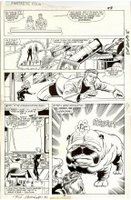My first piece was the opening splash page from Fantastic Four, vol. 3 #33 by Salvador Larocca. I bought it largely because, at the time, I had just had some great e-mail conversations with Salva and wanted to "commemorate" the event. I asked him what he had available, and he referred me to his art representative in the U.S. Nothing that was in stock at the time struck my fancy, and the rep said that I could reserve any future page that I wanted; however, the next several covers were already claimed. But, thanks to the infancy of the Internet, I was able to get one of the earliest previews of the upcoming issue and saw that it had a great opening splash, which I promptly sent off a check for.
That was my one piece of art for a couple of years, until I won Diamond's "Comics' #1 Fan" contest in 2003. Part of the prize package included several pieces of original comic art. Admittedly, they were not particularly high profile artsits or characters, but, overnight, I found that I had over a dozen pieces of art in my instant collection.
And so I began as a collector of original comic art.

My background in graphic design makes me somewhat privvy to the production process. So it's more interesting to me to see how the original artwork was created FOR the production process. I have little interest in obtaining commissioned pieces or convention sketches -- I'd much rather have the origianl art that was used in creating the comic book stories that I enjoy. I also think it's more interesting to see how different artists approach the same type of work.
My favorite piece in my own collection, so far, has to be the one shown here: Fantastic Four, vol. 3 #55, page 5 by Stuart Immonen. It's certainly a great piece of art in its own right, but it also showcases the actual production process that's gone into it. The inker, Karl Kesel, worked from an electronic copy, so all of Immonen's original pencil lines are left intact. You can even see his non-repro blue pencil underneath! Plus, there's the interesting blending of detail with shortcuts -- note his refernece in the third panel to stat the background of the fourth. Wonderful piece, in my opinion.

I also like this piece (at right) by Tom Morgan. It's page 43 from Fantastic Four Annual #22. The emptiness of the first panel always bugged me. It looked like something had been left out. Sure enough, once I received the art, I could see that the second panel was originally intended to break up into that area. Why it was changed, I don't know, but I now know it wasn't designed to be dead space. This page also sports gutter notes from Morgan. Evidently, as he was laying out the page, he scribbled in some directions about what was happening in each panel -- presumably to help him follow the story while he was still drawing it. Most are fairly straightforward descriptions, but the final panel notes the appearance of "Woofer, the Wonder Bunny!"
You don't see that kind of behind-the-curtain material just anywhere, and I find it fascinating to examine how my favorite medium is put together. It gives me a greater appreciation of the final story that I read in the printed page.






1 comments:
Hi Sean,
Glad you like the piece of art of mine and even better, glad you appreciate the creative process of creating art. For the record, and this art was created a looooooong time ago, the gutter notes were probably put in for the writer's sake. Back in the day we worked the "Marvel style" of drrawing, meaning we worked primarily from plot alone, not full script, so the artist was responsible for breaking down the pacing of the story. I usually added gutter notes in case the writer, who would be adding dialogue later, was not clear on what he was looking at. Thanks for posting the page.
Best,
Tom Morgan
Post a Comment